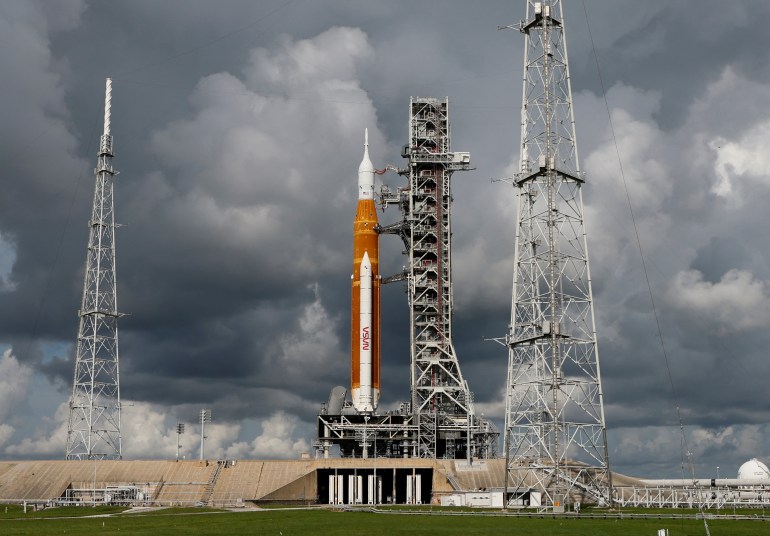The year 2024 was full of exciting space adventures and milestones that shaped the near and distant future alike in the space industry, starting with the major event with the success of SpaceX’s Starship vehicle in its first successful landing, which is the largest vehicle ever and which is planned to contribute to Landing the first human mission on Mars.
Then comes the impressive success of China, in which it proved its mettle after it was the first country to bring soil samples from the far side of the moon as part of the Chang’e space project to explore the moon. NASA’s Europa Clipper spacecraft also launched on a long journey towards Jupiter’s moon Europa. In an intensive study, the most powerful of its kind, to search for the possibility of life on it, and finally, the “Parker” space probe witnessed the breaking of a record by approaching the sun at a distance of only 6.1 million kilometers.
According to this amazing success in the space industry, our planet is heading towards a new year full of space missions that will be launched by government institutions and private commercial companies, in the context of broad global competition in this thriving scope.

Final preparations for the Artemis 2 flight
Work on the “Artemis” program, which is concerned with sending the first human crew to the moon after a break of more than 50 years, is still in full swing, with intense preparations for the second phase of the project, “Artemis 2”, which is the mission that will be undertaken by a crew of astronauts. By flying high in orbit around the moon to test the control and take-off systems using the Orion spacecraft designated for this flight.
In addition, all the main components of the Space Launch System hardware for the SLS rocket that will carry the spacecraft are now undergoing the final stage of testing in preparation for the next mission, including the rocket’s dual solid boosters, which are approximately 65 meters long.
In a press release from Sean Quinn, program manager for the Ground Exploration Systems crew based at NASA’s Kennedy Space Center, which develops and manages all the systems and facilities needed to handle rocket and spacecraft launches for the Artemis missions, Quinn says: We are looking at 2025, where… The teams will begin a pivotal year in which we will integrate equipment for the Artemis 2 mission, while at the same time developing the foundation for future Artemis missions that will return humans to the Moon.
NASA aimed to benefit from the efforts of the private sector through its “Commercial Lunar Payload Services” (CLPS) initiative, which aims to provide the opportunity for private companies to participate in the “Artemis” project by providing the agency with various scientific tools. This initiative has resulted in the sending of Intuitive Machines’ Odysseus lander to the Moon in February 2024, the first American-made lunar lander since the Apollo project in the 1970s.

Private sector trips
The new year is expected to witness more such flights in cooperation with the private sector, as the next flight will be “Blue Ghost Mission 1”, operated by “Firefly Aerospace”, which will transport 10 scientific and technological instruments, including the electrodynamic dust shield.
This technology is designed to remove fine dust particles, especially in environments such as the Moon or Mars, where dust poses a major challenge due to its extreme viscosity. The technology relies on using electric fields generated by electrodes to create oscillating electrical forces that work to push dust off surfaces such as solar panels and astronauts’ helmets. Space and other equipment.
Intuitive Machines will also work on implementing a new trip to the moon, including the first practical experience of extracting lunar resources, which is similar to the ice mining process. Both trips are expected to take place in the first quarter of the new year.

One eye is on the universe and the other is on the sun
NASA’s Launch Services Program is working to enhance scientific capabilities by launching 3 new space missions over the next year, the most prominent of which is the launch of the new Spherex space telescope aboard a Falcon 9 rocket from Vandenberg Space Base.
The telescope aims to conduct the first comprehensive spectral survey of the universe using visible light and near-infrared light, within a two-year mission, where it will collect data on more than 450 million galaxies, in addition to more than 100 million stars within the Milky Way galaxy.
Astronomers will use this data to answer fundamental questions regarding the origin of galaxies and the distribution of water and organic molecules in regions where stars are born from cosmic gas and dust.
In conjunction with the launch of SpherX, NASA is also working to send a group of “Ponch” class satellites into near-Earth orbit. These satellites will cooperate in monitoring the transmission of the solar corona (corona) via solar wind, which contributes to improving space weather forecasting that directly affects… On satellites, communications networks and energy infrastructure on Earth.
In late 2025, the IMIB mission will launch from Cape Canaveral with the aim of drawing a detailed map of the heliosphere, which is the magnetic field that surrounds our solar system and provides protection for it. The mission will rely on 10 advanced devices to collect data, and targets the “Lagrange 1” equilibrium point. “Located between the Earth and the Sun, spacecraft and satellites can easily maintain their orbits.
Deputy Launch Services Program Jenny Lyons said that the missions that will be launched next year will include pioneering technologies that will help us learn more about the universe than ever before, and will provide new data to researchers that will benefit the people of Earth.
Return to the moon through the Japan Gate
The Resilience mission of the Japanese company I Space, scheduled to be launched in January 2025, aims to send a lander and a small robot to the moon. This mission will focus on studying the composition of lunar soil and its physical properties, in addition to implementing an innovative water separation experiment with the aim of… Production of oxygen and hydrogen. This experiment will be carried out by extracting water from the surface of the moon, then heating it and turning it into steam, and then separating the steam into its basic components.
The mission will also provide an opportunity to test advanced technologies, including precise navigation systems to achieve a perfect landing, in addition to autonomous operating systems for devices and robots. These innovations represent a vital step towards future lunar exploration, with the potential to be applied to other exploration missions, including future missions to Mars.
This mission comes as an extension of recent Japanese achievements, after the success of the “Slim” spacecraft, which landed on the moon in March 2024, showcasing advanced technologies to achieve unprecedented accuracy in landing.
In this context, Takeshi Hakamada, founder and CEO of iSpace, said through a press release published on the official website: “I am very pleased to announce that the assembly and integration of the Resilience lander has been completed, and we are committed to the specified schedule for its launch.” The vehicle is expected to be launched early in the new year as planned.
The first commercial space station
The International Space Station is entering the final stages of its lifespan, and it is expected that it will stop operating by the year 2030, and with the absence of any intention on the part of those in charge of the station, such as NASA and the Russian Space Agency, to build an alternative station to replace it, there are other options that have emerged on the scene to be the successor. Expected, “Fast” Company, the leader in building housing and space units, is one of the most important developers in this field.
Earlier, since its founding in 2021, the company had built a prototype of a mini-space station, “Haven-1,” which is expected to become the world’s first commercial space station when it launches later in 2025.
“Haven-1” represents a single space module, 10.1 meters long and 4.4 meters wide, and can accommodate 4 astronauts at one time. The company had announced that a Falcon 9 rocket would be assigned to lift the space module into space.
While Fast Company is working on developing its own space station, the company plans to benefit from additional missions to the International Space Station in cooperation with NASA, and this will enhance the company’s own expertise in achieving the correct engineering construction taking into account all space conditions, in addition to that the spacecraft “ Dragon will carry the first space crew when the space module is completed later, and Haven-1 will be fully supported by high-speed satellite Internet service via the Starlink network.
In addition, FAST Company signed an agreement with the European Space Agency in mid-2024, which defines the framework for cooperation in each of the cognitive, technological and commercial fields as well, and the European Space Agency aims to send the first space crew to Haven-1 by the year 2026.
The “Tianwen-2” mission.. China does not stop!
The Chinese “Tianwen-2” mission represents one of the important pillars of China’s ambitious space program, as it focuses on collecting samples from asteroids and exploring comets flying near Earth. This mission is scheduled to be launched in May 2025, and it is expected to contribute to enhancing Scientists understand the formation and evolution of the solar system, drawing on China’s successes in previous Moon and Mars missions.
The first target of the mission is the near-Earth asteroid known by the code “469219 Ka Mu Oa Liva.” It revolves around the sun close to the Earth, and its diameter is about 40 to 100 meters, and it is likely that it is part of the Earth’s moon that was thrown into space as a result of an ancient collision.
After collecting the required samples, the Tianwen-2 space probe will return to Earth, then head to its second target, which is the comet located in the asteroid belt between Mars and Jupiter. By analyzing the materials of this comet, scientists hope to gain more understanding about the conditions under which it was. Prevailing in the early solar system, perhaps discovering the origin of the presence of water and organic molecules on Earth.

